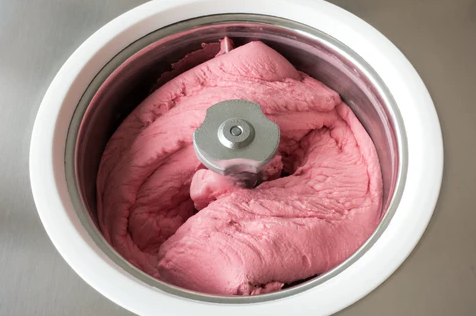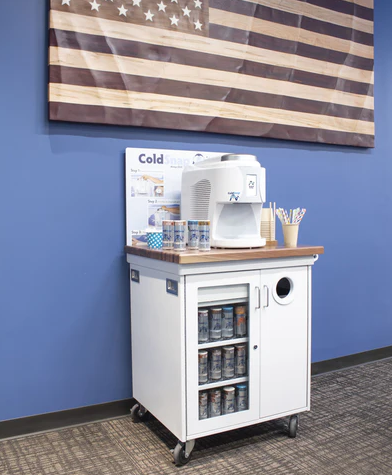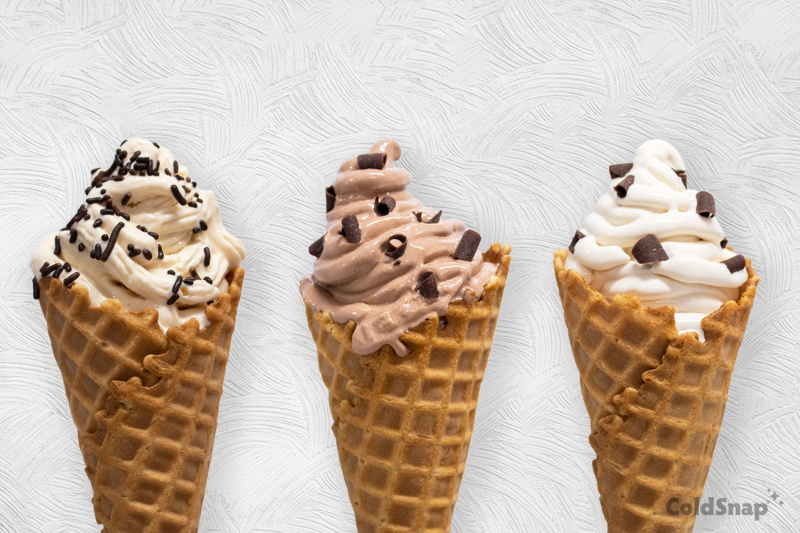At ColdSnap, we’re in the business of treating foodies and culinary rookies to the most decadent ice cream and frozen confections. With so many sweet frozen options at our fingertips, have you ever wondered, “What is real ice cream?”
Once you gain an understanding, it will enlighten your eyes (and palate) to the variety of frozen treats out there and help you decide as you peruse the frozen section of the grocery store. It will also enable you to understand ColdSnap’s ice cream offerings!
Creamy ColdSnap Ice Cream
When people try ColdSnap ice cream for the first time, their first expression is usually “Wow! That’s so creamy!” The ColdSnap ice cream machine mixes and freezes ice cream in two quick minutes; and the creaminess of our product is largely due to our proprietary freezing process that produces ice cream with the smallest possible ice crystals. The other part of the equation is that ColdSnap ice cream is real ice cream.
ColdSnap ice cream is freshly frozen and dispensed in a soft style, at the perfect temperature. Plus it’s made with premium ice cream ingredients. This combination of the ideal temperature, the best ingredients, and tiny ice crystal size makes ColdSnap an unparalleled ice cream experience: smooth, decadent, and absolutely delicious.
On the other hand, frozen desserts sold as soft serve often do not meet the criteria of ice cream. We’re not trying to be ice cream elitists, but there are significant differences between ice cream and other types of frozen desserts. We’ll unpack them here.
Ice Cream, Defined
Did you know that there are regulations for what is considered ice cream? Here’s how the definition begins:
Ice cream is a food produced by freezing, while stirring, a pasteurized mix consisting of one or more optional dairy ingredients… (21 CFR 135.110)
It is probably no surprise that ice cream is frozen, and if you’ve ever attempted to make ice cream at home, you know it must also be mixed. There are other requirements, though, that must be met for a frozen dessert to be labeled “ice cream.” While there are several criteria, we’ll talk about one key factor, milkfat, here. Then we’ll let you in on another, lesser-known part of the ice cream “mix.”

Milkfat %
Ice cream must contain at least 10% milkfat (sometimes called butterfat). Since anything less than that isn’t considered real ice cream, you may be interested to learn that your favorite fast-food chain’s soft serve most likely does not make the cut. For a product to be labeled (or listed on a menu) as ice cream, it must contain at least 10% milkfat.
Most, though not all, soft serve comes in between 4-7% milkfat. Delicious? Of course. As decadent as real ice cream? Probably not. So, when you hear people talk about soft serve ice cream, what they’re talking about may or may not meet the standards for actual ice cream. Ah, technicalities.
You can use your new knowledge to impress your friends as you enjoy frozen desserts together. You could say something like, “Mmm, this vanilla cone is tasty, but it does seem a bit icier than the dipped swirl I got yesterday. I bet this isn’t real ice cream.” Then you can really flex when you explain that not all soft serve is ice cream. Your friends may judge you for eating so many treats but will be wowed by your keen soft-serve perception skills.
ColdSnap ice cream is not only real ice cream, but it is considered premium ice cream. Premium ice cream contains around 12%-14% milkfat, and ColdSnap ice cream comes in at 14%. This makes it creamy and extra satisfying.
Overrun
Another critical factor in the world of ice cream is something called overrun. During the mixing and freezing process, air is whipped into the ice cream. The resulting increase in ice cream volume is called overrun.
Lower-quality ice cream typically has a higher overrun than premium ice cream – aka more air is incorporated into the treat. For manufacturers, packing ice cream full of air helps keep costs down, and some products can have as much as 100% overrun (or more). High-overrun products, however, are not usually as decadent or satisfying to consume. With only 35% overrun, ColdSnap ice cream is dense and delicious.
How to Tell if a Frozen Dessert is Real Ice Cream
If you’re at the grocery store, you can easily tell ice cream apart from other frozen treats. Products that meet the requirements for ice cream will be labeled “ice cream.” Anything else will be called “frozen dessert” or some other creative name.
If you’re looking at a restaurant’s menu, the same thing applies. Only actual ice cream can be listed as such. If the requirements for real ice cream, including at least 10% milkfat, are not met, you’ll see frozen confections listed in other ways. Here are just a few: Soft Serve, Vanilla Cone, Frozen Dairy Treat, and of course, Frozen Dessert.
What about non-dairy frozen treats? It probably comes as no surprise that non-dairy frozen treats cannot be labeled as ice cream. After all, part of the definition of ice cream is that it contains dairy. So, instead, you’ll see labels such as “frozen dessert.”
We hope we’ve helped demystify ice cream and other frozen treats just a bit. Our goal is not to make you an ice cream snob, but to help you appreciate the differences between frozen treats. Have fun trying different ice cream shops and see what you notice – what do your tongue and taste buds say about the amount of milkfat and amount of air that’s been whipped in? What do you notice about the flavors?

Find yourself craving some real ice cream? ColdSnap’s rapid freezing appliance dishes out premium ice cream, as well as other treats like frozen coffee and frozen smoothies, frozen on demand in approximately two minutes. To learn more about how ColdSnap can bring the chill to your workplace or event, please send us a message.
Get the Scoop
Stay in the loop on all things ColdSnap with our newsletter.
Categories
Recent Posts
- ColdSnap Partners With Foodbuy to Deliver On-Demand Frozen Treats to Foodservice Operators
- Your Morning Just Got a Whole Lot Smoother: How to Make a Delicious & Healthy Smoothie with ColdSnap
- 7 Reasons Every Golf Course Needs a ColdSnap Machine
- Empowering Students with Self-Serve Frozen Treats — No Hassle, All Joy
- Ice Cream on Demand…From a Can??


